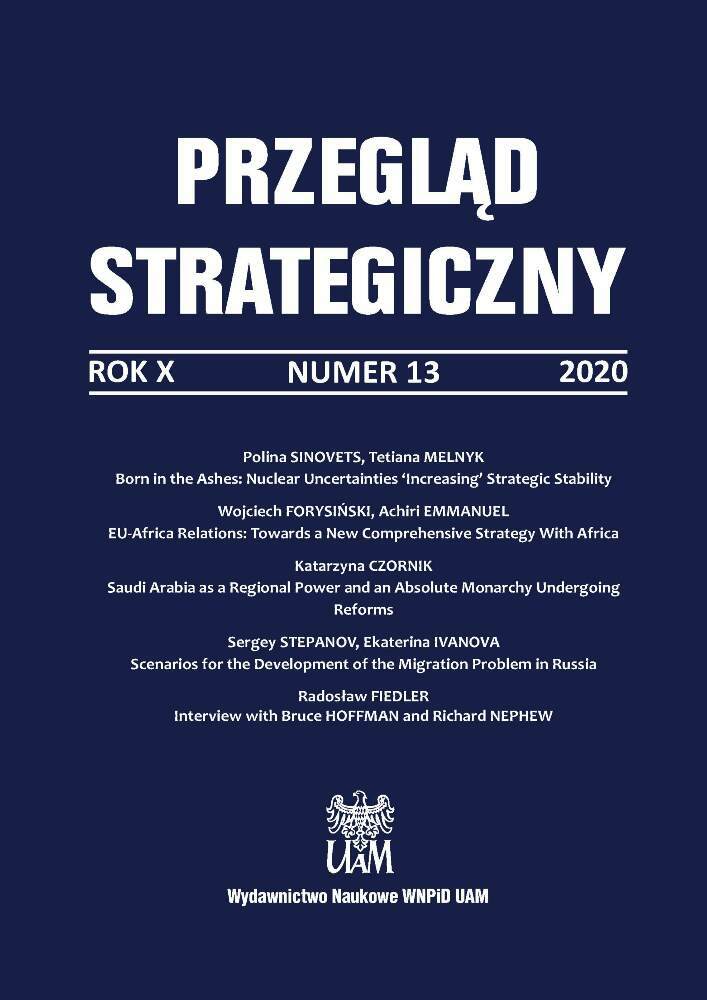Abstract
This article analyzes the rise and evolution of Boko Haram, a Nigerian jihadist organization operating since March 2015 under the banner of Islamic State. The key changes in the ideology, tactics, and goals of Boko Haram have been identified providing in-depth insight into how and why the organization has evolved. The evolution of jihadist activity of Boko Haram included at least two dimensions: firstly – the extreme radicalization of paramilitary struggle manifested in the massacres of civilians in rural areas; and secondly – the feminization of jihadist activity with special regard to the involuntary participation of young women in suicide bombings. The analysis of the facts discussed in the article is based on one of the qualitative scientific methods, namely case study. The main reason to apply this method is the need to investigate the above-mentioned changes in the activity of Islamic terrorists within the time limits indicated in the title of the article.
References
Adesoji A. (2010), The Boko Haram Uprising and Islamic Revivalism in Nigeria / Die Boko-Haram-Unruhen und die Wiederbelebung des Islam in Nigeria, “Africa Spectrum”, Vol. 45, No. 2.
Adebayo B. (2019), 30 dead in triple suicide bomb blasts in Nigeria, CNN, 17.06.2019, https://edition.cnn.com/2019/06/17/africa/nigeria-triple-bomb-blasts-intl/index.html (March 2020).
AFP (2015), 20 shot dead by suspected Islamists in NE Nigeria: locals, AFP, 22.10.2015, https://news.yahoo.com/20-shot-dead-suspected-islamists-ne-nigeria-witnesses-224347258.html (March 2020).
Agbiboa D. E. (2013), The Ongoing Campaign of Terror in Nigeria: Boko Haram versus the State, “Stability: International Journal of Security and Development”, Vol. 2, Issue 3, DOI: 10.5334/sta.cl.
Agbiboa D. E. (2014), Peace at Daggers Drawn? Boko Haram and the State of Emergency in Nigeria, “Studies in Conflict & Terrorism”, Vol. 37, Issue 1, DOI: 10.1080/1057610X.2014.853602.
Antwi-Boateng O. (2017), Boko Haram and the Islamic State: A Tale of Two Terrors, “Conflict Studies Quarterly”, Issue 18, January 2017.
Anugwom E. E. (2019), The Boko Haram Insurgence in Nigeria. Perspectives from Within, Palgrave Macmillan, Cham.
Barkindo A. F. (2016), Boko Haram-IS Connection: Local and Regional Implications, “Counter Terrorist Trends and Analysis”, Vol. 8, Issue 6, June 2016.
Bartolotta C. (2011), Terrorism in Nigeria: The Rise of Boko Haram, “World Policy Journal”, http://worldpolicy.org/2011/09/19/terrorism-in-nigeria-the-rise-of-boko-haram/ (March 2020).
BBC (2015), Nigeria Boko Haram crisis: Militants ‘kill 150’, BBC News, 2.07.2015, https://www.bbc.com/news/world-africa-33369713 (April 2020).
Brakoniecka S. (2015), Wpływ przywództwa Abubakra Shekau na rozwój organizacji Boko Haram, “Afryka”, No. 42.
Brakoniecka S. (2017), Salafizm wobec władzy świeckiej – myśl polityczna Muhammada Yusufa, ideologa organizacji Boko Haram, “Afryka”, No. 45.
Celso A. N. (2015), The Islamic State and Boko Haram: Fifth Wave Jihadist Terror Groups, “Orbis”, Vol. 59, Issue 2, DOI: 10.1016/j.orbis.2015.02.010.
Eke S. J. (2015), How and why Boko Haram blossomed: Examining the fatal consequences of treating a purposive terrorist organisation as less so, “Defense & Security Analysis”, Vol. 31, Issue 4, DOI: 10.1080/14751798.2015.1087102.
Ekhomu O. (2020), Boko Haram: Security Considerations and the Rise of an Insurgency, CRC Press, Taylor & Francis Group, Boca Raton–London–New York.
Faluyi O. T., Khan S., Akinola A. O. (2019), Boko Haram’s terrorism and the Nigerian state. Federalism, politics and policies, Springer, Cham.
Femi A. (2013), Boko Haram: The emergence of a terrorist sect in Nigeria 2009–2013, “African Identities”, Vol. 11, No. 3, DOI: 10.1080/14725843.2013.839118.
Fulani I. D. (2015), October 1 Tragedy: Boko Haram strikes in Adamawa, slaughters 5, “Premium Times”, 1.10.2015, https://www.premiumtimesng.com/news/top-news/190893-october-1-tragedy-boko-haram-strikes-in-adamawa-slaughters-5.html (March 2020).
Gray S., Adeakin I. (2015), The Evolution of Boko Haram: From Missionary Activism to Transnational Jihad and the Failure of the Nigerian Security Intelligence Agencies, “African Security”, Vol. 8, Issue 3, DOI: 10.1080/19392206.2015.1069120.
Kozera C. A., Popławski B. (2018), Boko Haram, al-Qaeda in the Islamic Maghreb, al-Shabaab – Similarities and Differences. Analysis of the Genesis, Evolution, and Strategies of the Islamist Violent Extremist Groups in Africa, Center for Strategic and Defense Studies, CSDS Viewpoints, 2018/3.
Mark M. (2015), Thousands flee as Boko Haram seizes military base on Nigeria border, “The Guardian”, 5.01.2015, https://www.theguardian.com/world/2015/jan/05/boko-haram-key-military-base-nigeria-chad-border (April 2020).
Moore J. (2015), Nigerian Military Enter ‘Final Stages’ of Boko Haram Offensive, “Newsweek”, https://www.newsweek.com/nigerian-military-enter-final-stages-boko-haram-offensive-324384 (March 2020).
Muscati S. (2015), Anatomy of a Boko Haram Massacre, Human Rights Watch, 10.06.2015, https://www.hrw.org/news/2015/06/10/anatomy-boko-haram-massacre (March 2020).
NAN (2016), Scores die in terrorists attack in Dalori, Borno, “The Guardian”, 31.01.2016, https://guardian.ng/news/scores-die-in-terrorists-attack-in-dalori-borno/ (March 2020).
Oftedal E. (2013), Boko Haram – an overview, Norwegian Defence Research Establishment (FFI), https://publications.ffi.no/nb/item/asset/dspace:2365/13-01680.pdf (March 2020).
Onuoha F. (2010), The Islamist Chellenge: Nigeria’s Boko Haram Crisis Explained, “African Security Review”, Vol. 19, Issue 2, DOI: 10.1080/10246029.2010.503061.
Pham J. P. (2016), Boko Haram: The strategic evolution of the Islamic State’s West Africa Province, “The Journal of the Middle East and Africa”, Vol. 7, No. 1, DOI: 10.1080/21520844.2016.1152571.
Piłaszewicz S. (2012), Odrodzenie i radykalizacja Boko Haram, “Afryka”, No. 36.
Sawab I., Hartocollis A., Ives M. (2019), Nigerians Flee After Men on Motorbikes Shoot Down Mourners, “The New York Times”, 29.07.2019, https://www.nytimes.com/2019/07/29/world/africa/nigeria-attack-boko-haram-funeral-.html (March 2020).
UNICEF (2017), Use of children as ‘human bombs’ rising in north east Nigeria, UNICEF, 22.08.2017, https://www.unicef.org/press-releases/use-of-children-human-bombs-rising-north-east-nigeria (March 2020).
Waldek L., Jayasekara S. (2011), Boko Haram. The evolution of Islamist extremism in Nigeria, “Journal of Policing, Intelligence and Counter Terrorism”, Vol. 6., No. 2, October, DOI: 10.1080/18335330.2011.605217.
Wejkszner A. (2017), Globalna sieć Al-Kaidy. Nowe państwo islamskie?, Warszawa.
Wojciechowski S., Osiewicz P. (2017), Zrozumieć współczesny terroryzm. Wybrane aspekty fenomenu, Warszawa.
Zenn J. (2015), A Biography of Boko Haram and the Bay’a to al-Baghdadi, “CTC Sentinel”, Vol. 8, Issue 3, March.
Zenn J. (2020), Boko Haram’s Conquest for the Caliphate: How Al Qaeda Helped Islamic State Acquire Territory, “Studies in Conflict & Terrorism”, Vol. 43, Issue 2, DOI: 10.1080/1057610X.2018.1442141.

